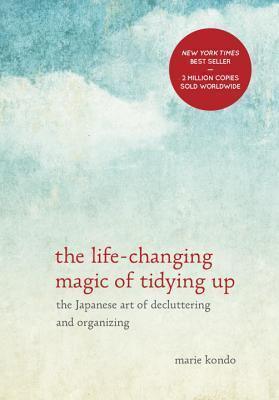Tidying Up
I read the most charming book, recently. It’s called The Life-Changing Magic of Tidying Up: The Japanese Art of Decluttering and Organizing, by Marie Kondo. The author is a television star in Japan, where she has a show in which she . . . you guessed it, goes to people’s houses and helps them organize their possessions. Helps them tidy up. After reading the book, I watched clips from several episodes on YouTube, in Japanese of course. A lot of what she does is talk to people, and I’m guessing that she’s asking them what they love, which of their possessions are truly important to them. Because Kondo has a different approach to tidying up, one I found interesting and valuable.
The book is charming in part because Kondo is so obsessive, much more than I could ever be. But I’m going to describe what I found valuable in her book, the ideas that stood out to me. Because I need order to work well — I need my environment to be tidy.
I know there have been articles on writers and how messy they can be. Some of them need mess, need disorder — they say within that disorder, they know where everything is. They get angry if anyone tries to tidy up. I’m not like that: I need my environment to be organized. I think it has to do with the way I think. My mind is itself a tidy place, or wants to be. It doesn’t like to be untidy, with important things tucked into the wrong places and forgotten. I do so much, have so many projects at once, that it’s really the only way I can operate. And one of the best ways to tidy my mind is to keep my physical environment clean, clearly organized. I don’t like inner or outer mess.
There are two other reasons I don’t like mess. One is that I need to live efficiently. I have so much to do that it’s frustrating when I have to spend time searching for a set of notes I knew I put somewhere. Or keys. Or change. If I’m working on a research project, I need to know which books I have relevant to that project, and where to find them. And second, I want to live in a beautiful space. Mess can be beautiful, but have you noticed that a beautiful mess is almost always intentional and intensely curated? Edward Gorey’s house was a beautiful mess, but he was an artist. It’s actually much more difficult to create a beautiful mess than simple neatness. So I try to keep things neat.
But I do fall into messiness sometimes, particularly when I don’t have time to clean. When I’m simply too busy.
So here are the central concepts from Kondo’s book that are particularly important to me:
1. You should only have things that bring you joy. This was a revelation, actually. What Kondo does, and I did not do this, is have people bring out all their possessions and put them on the floor. Then, she tells them to hold each one in their hands and decide whether that item brings them joy. If it doesn’t, it goes.
I thought I was being very practical by keeping things I had not worn for a long time, because I might need them again someday. But Kondo would say, while those things were useful to you once, they have outlived their usefulness. They are now ready to go away, wherever they’re supposed to go next. In a way, by keeping them, you’re impeding the flow of both your and their lives. Someone else could potentially use that coat. And then there are things that have outlived their usefulness entirely, and simply need to be thrown away. Old receipts don’t necessarily want to stay with you, to clutter up your drawers. They know when it’s time for them to move on, and so should you.
Did I mention that Kondo talks a fair amount about Shinto? It’s very clear that she believes all your things have spirit. If they’re no longer giving you joy, not only should they move on, they actually want to move on.
This prompted me to go through my closets and bookshelves. I try not to keep things I don’t love, but even I found things I was keeping that didn’t give me joy: some books I had bought because I felt as though I should read them, some clothes that were such a bargain at the time. I took several large bags to Goodwill.
2. Once you have discarded everything that doesn’t give you joy, make sure everything you’re keeping has its proper place. You should have a designated place for everything.
3. And you should make a habit of putting everything in its place. Now, this is difficult for me at the moment. Although I moved into this apartment six months ago, I’m still decorating. So there are paint cans on the kitchen counter, which is clearly not a place to store paint cans. (I just painted three lamps, and next come the shelves in what I glamorously call the walk-in closet, because you can walk into it, but is really a tiny room under the stairs, with a rod and drawers.) But I do try to make sure that whenever I take anything out of its place, I put it back. I notice that if it’s sitting out of place after I used it, I start to feel uncomfortable. This is partly Kondo’s fault: she makes me feel as though everything I own is sentient! As though my socks have feelings. (And how do I know they don’t?) Things like to be in their proper places, she says. And I know mine do.
There is a final concept in her book that I really like. She says that every day, when you enter your home, you should bow to it and thank it, and all the things in it, for taking care of you. For sheltering you, supporting you. Because after all, that’s what your things do, from socks to frying pans. I don’t actually bow down to my apartment (or at least not often!), but I like the idea of gratitude toward your things. That’s where the impulse to keep them neat, to take care of them back, ultimately comes from.





